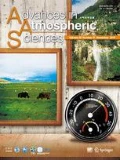Abstract
The water vapor transport model at the regional boundary in the Meiyu period is put forward through diagnostic analysis. The numerical simulation on the water vapor transport at the boundary of China in the heavy rainfall period during June–July 1998 shows that the feature of water vapor transport in June is different from that in July. The main body of the water cycle that forms the torrential rain in the Yangtze River Valley is made up of water vapor transport at the western and southern boundaries of the China region in June, whereas the water vapor flow at the western boundary in middle Tibet turns out to be the main body of water vapor sources in July. The water vapor transport at the western boundary of the Tibetan Plateau and the southern boundary of China plays an important role in the torrential rain in the Yangtze River Valley. The temporal and spatial distribution characteristics of water vapor flow at the regional boundary and their theoretical model would provide the scientific proof for the heavy rain forecasts in the Yangtze River Valley.
Similar content being viewed by others
References
Fei Jianfang, Qiao Quanming, and Gao Taiping, 1993: A study of vapour transport over Asian monsoon region in Meiyu season of 1983.Quarterly Journal of Applied Meteorology,4(1), 65–71. (in Chinese)
Giorgi, F., M. R. Marinucci, and G. T. Bates, 1993a: Development of a Second-Generation Regional Climate Model (RegCM2). Part I: Boundarylayer and radiative transfer processes.Mon. Wea. Rev.,121, 2794–2813.
Giorgi, F., M. R. Marinucci, G. T. Bates, and G. D. Canio, 1993b: Development of a Second-Generation Regional Climate Model (RegCM2). Part II: Convective processes and assimilation of lateral boundary conditions.Mon. Wea. Rev.,121, 2814–2832.
Liu Guowei, 1997:The Atmospheric Process of the Hydrological Cycle. Science Press, Beijing, 181–182. (in Chinese)
Wang Jizhi, Zhang Guangzhi, Yang Yuanqin, and Xu Xiangde, 2000: A Study on the Relationship between Cumulous Convective System from Tibetan Plateau and ’98 Flooding in China by Using ’98 TIPEX Data.Proceedings of the 2rd Session of International Workshop on TIPEX-GAME/Tibet, Kunming, China, 4, 137–139.
Wu Guoxiong, 1990: Atmospheric transports and budgets of water vapour and their impacts on subtropical drought.Scientia Atmospherica Sinica,14 (1), 53–63. (in Chinese)
Xu Xiangde, Li Yuefeng, and Miao Qiuju, 2000a: Dynamic Effects of Surface Moisture Situation in The West of Tibetan Plateau on Regional Climate Changes in China.The Development on the 2nd Tibetan Plateau Science experiment (TIPEX), 2, China Meteorological Press, Beijing, 195–205. (in Chinese)
Xu Xiangde, Zhang Xuejin, Zhou Mingyu, and Bai Jinyu, 2000b: Dynamic Feature of the Impact of the Thermal Anomaly of Tibetan Plateau Underlying Surface on the Drought-flood in Yangtze-Huaihe River Basin.The Development on the 2nd Tibetan Plateau Science experiment (TIPEX), 3, China Meteorological Press, Beijing, 1–15.(in Chinese)
Xu Xiangde, and Coauthers, 2002a, A comprehensive physical pattern of land-air dynamic and thermal structure on the Tibetan Plateau.Science in China,D45(7), 577–594.
Xu Xiangde, Tao Shiyan, Wang Jizhi, Chen Lianshou, Zhou Li, and Wang Xiurong, 2002b: The relationship between water vapor transport features of Tibetan Plateau-monsoon “large triangle” affecting region and drought-flood abnormality of China.Acta Meteorological Sinica,60(3), 257–266. (in Chinese)
Zhang Renhe, 2001: Relations of water vapor transport from Indian Monsoon with that over East Asia and the summer rainfall in China.Advances in Atmospheric Sciences,18(5), 1005–1017.
Zhou Jun, Xue Yufeng, and Liu Xuanfei, 1998: The source/sink distribution of water vapor with its transfer in Asian monsoon region in August of 1994.Journal of Tropical Meteorology,14(1), 91–96. (in Chinese)
Author information
Authors and Affiliations
Rights and permissions
About this article
Cite this article
Xu, X., Miao, Q., Wang, J. et al. The water vapor transport model at the regional boundary during the Meiyu period. Adv. Atmos. Sci. 20, 333–342 (2003). https://doi.org/10.1007/BF02690791
Received:
Revised:
Issue Date:
DOI: https://doi.org/10.1007/BF02690791



